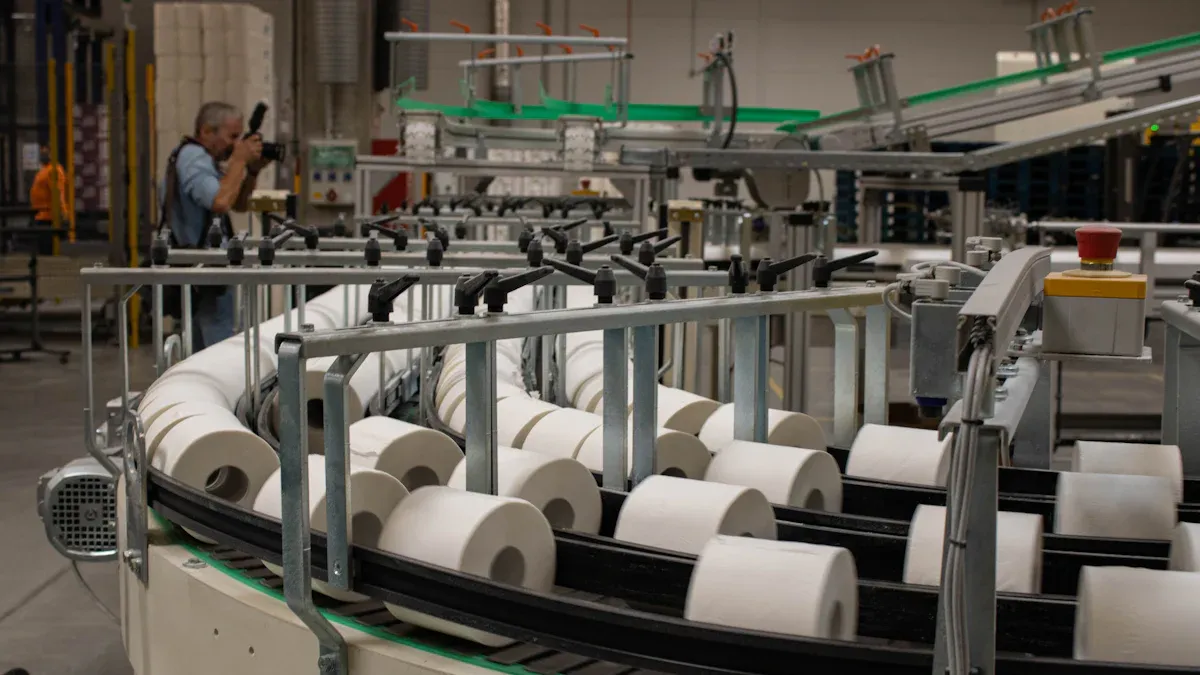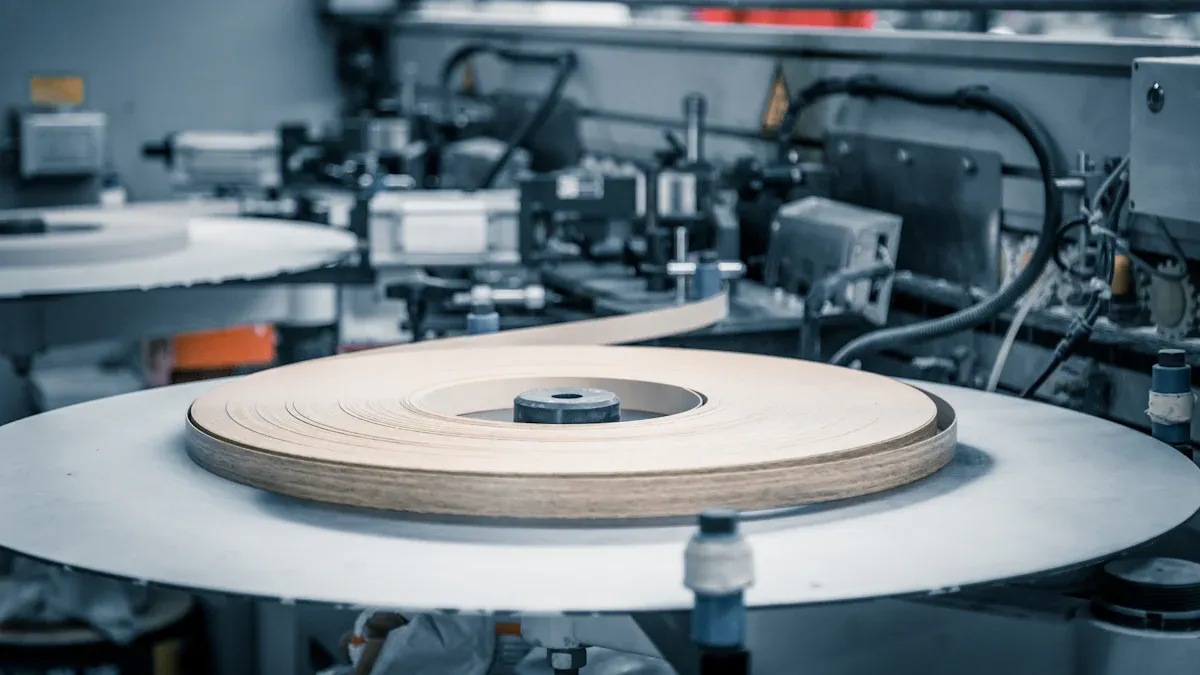Jumbo Parent Mother Roll Toilet Paper plays a vital role in the tissue paper industry. Its production supports the growing demand for high-quality paper products worldwide. Why does this matter? The global tissue paper market is booming. It’s expected to grow from $85.81 billion in 2023 to $133.75 billion by 2030. Emerging markets and rising production in regions like China, which consumes 12 million tons of paper annually, show how important parent roll tissue paper is for meeting these demands. Curious about how raw materials parent paper transforms into parent roll toilet tissue? Let’s explore!
Materials and Techniques in Jumbo Parent Mother Roll Toilet Paper Production

Types of Pulp: Virgin vs. Recycled
The foundation of any high-quality Jumbo Parent Mother Roll Toilet Paper lies in the type of pulp used. Manufacturers typically choose between virgin pulp and recycled pulp, each offering unique benefits. Virgin pulp comes directly from wood fibers, making it stronger and softer. It’s ideal for premium toilet paper that prioritizes comfort. On the other hand, recycled pulp is made from post-consumer paper products. It’s an eco-friendly option that reduces waste and conserves resources.
Choosing between these two depends on the product’s purpose. For instance, virgin pulp works well for luxury toilet paper, while recycled pulp suits budget-friendly or environmentally conscious products. Many manufacturers blend both types to balance quality and sustainability. This approach ensures the final product meets diverse consumer needs while minimizing environmental impact.
Additives for Strength, Softness, and Absorbency
Additives play a crucial role in enhancing the properties of Jumbo Parent Mother Roll Toilet Paper. They improve strength, softness, and absorbency, which are essential for customer satisfaction. Research shows that incorporating additives like CBA (cationic bonding agents) and CMF (cellulose microfibers) can significantly alter tissue properties. For example, a blend of 90% eucalyptus fibers and 10% softwood fibers achieved a softness score of 68 HF, a tensile index of 15 Nm/g, and a water absorption capacity of 8 g/g. Adding 3% CBA increased softness to 72 HF without compromising strength or absorbency.
However, manufacturers must strike a balance. While additives enhance tensile strength, excessive amounts can reduce softness and absorbency. Cost is another factor. Adding more than 10% CMF, for instance, becomes economically unviable. By carefully selecting and balancing additives, manufacturers can create toilet paper that meets both performance and cost expectations.
Importance of Material Selection for Quality and Sustainability
Material selection is the backbone of producing high-quality and sustainable Jumbo Parent Mother Roll Toilet Paper. The right materials ensure efficiency, cost-effectiveness, and adherence to industry standards. Here’s a closer look at why material choice matters:
| Quality Metric | Description |
|---|---|
| Efficiency in Production | High-quality materials enhance production efficiency, reducing interruptions and downtime. |
| Cost-Effectiveness | Superior materials minimize waste and maintenance costs, leading to long-term savings. |
| Standards and Certifications | Adherence to industry standards ensures consistent product quality and builds consumer trust. |
| Testing and Inspection | Regular testing maintains high-quality standards, ensuring only the best materials are used. |
Sustainability is equally important. Consumers increasingly prefer eco-friendly products, and manufacturers must adapt. Using recycled pulp, reducing waste, and adopting sustainable practices not only benefit the environment but also build brand loyalty. By prioritizing quality and sustainability, manufacturers can stay competitive in the evolving tissue paper market.
Step-by-Step Manufacturing Process

The production of Jumbo Parent Mother Roll Toilet Paper involves several carefully designed steps. Each stage plays a crucial role in transforming raw materials into high-quality rolls that meet consumer expectations. Let’s break it down step by step.
Pulping: Breaking Down Raw Materials
The journey begins with pulping, where raw materials like wood chips or recycled paper are broken down into fibers. This step is essential for creating a uniform base for the final product. Manufacturers use chemical or mechanical processes to separate the fibers. Chemicals like sodium sulfite (Na₂SO₃) and sodium carbonate (Na₂CO₃) are often added to enhance the pulping process.
| Variable | Range | Effect on Properties |
|---|---|---|
| Na₂SO₃ charge | 8–18% w/w on oven-dry wood | Notable effect on pulp and black liquor properties |
| Na₂CO₃ charge | 0.5–3.0% w/w on oven-dry wood | Significant impact on evaluated properties |
| Maximum cooking temperature | 160–180 °C | Less significant effect compared to other variables |
| Optimal sulphite charge | 9.4% w/w on oven-dry wood | Maximizes short-span compression strength index to 26.7 N m/g |
| Optimal carbonate charge | 1.94% w/w on oven-dry wood | Contributes to maximizing pulp strength properties |
The table above highlights how different variables influence the pulping process. For instance, using an optimal sulphite charge of 9.4% ensures strong and durable fibers. This step sets the foundation for the strength and softness of the final product.
Paper-Making: Forming the Jumbo Rolls
Once the fibers are ready, they move to the paper-making stage. Here, the fibers are mixed with water to form a slurry. This mixture is spread onto a moving screen, where water drains away, leaving behind a thin layer of wet paper.
The thermo-mechanical pulping (TMP) process is often used during this stage. It achieves an impressive production yield of about 97%. This means nearly all the original wood chips are converted into usable paper fibers. The TMP process is not only efficient but also resource-friendly, making it a popular choice among manufacturers.
As the wet paper moves along the production line, it begins to take shape. Layers are added to achieve the desired thickness, and the paper is wound into large rolls. These rolls, known as Jumbo Parent Mother Roll Toilet Paper, are the backbone of the tissue paper industry.
Drying and Finishing: Achieving Desired Texture and Thickness
The final stage involves drying and finishing. The wet paper passes through heated rollers that remove any remaining moisture. This step is crucial for achieving the right texture and thickness.
Manufacturers often use a combination of heat and pressure to create a smooth, soft surface. Some even emboss patterns onto the paper to enhance its appearance and functionality. Once dried, the paper is trimmed and cut into smaller rolls or sheets, depending on its intended use.
By the end of this process, the Jumbo Parent Mother Roll Toilet Paper is ready for distribution. Its quality and consistency depend on the precision of each step, from pulping to finishing.
Quality Control and Environmental Considerations
Ensuring Consistency and Standards in Production
Consistency is key when manufacturing Jumbo Parent Mother Roll Toilet Paper. Every roll must meet strict quality standards to satisfy customer expectations. Manufacturers achieve this by implementing rigorous quality control measures. These include regular inspections, automated monitoring systems, and standardized testing procedures.
For example, sensors on production lines can detect variations in thickness or texture. If an issue arises, the system alerts operators to make adjustments. This ensures every roll maintains the same high quality. Additionally, manufacturers often follow certifications like ISO 9001, which guarantees adherence to global quality standards.
Sustainable Practices and Waste Reduction
Sustainability has become a priority in the tissue paper industry. Companies now focus on reducing waste and conserving resources during production. One effective method is recycling water used in the paper-making process. This reduces water consumption and minimizes environmental impact.
Another approach involves repurposing by-products like pulp sludge. Instead of discarding it, manufacturers use it to generate energy or create compost. These practices not only cut waste but also lower production costs.
Tip: Choosing recycled pulp over virgin pulp is another way manufacturers promote sustainability. It reduces deforestation and supports a circular economy.
Trends in Eco-Friendly Manufacturing for 2025
The future of manufacturing lies in eco-friendly innovations. By 2025, more companies will adopt green technologies to produce Jumbo Parent Mother Roll Toilet Paper. For instance, renewable energy sources like solar and wind power will replace traditional energy. This shift reduces carbon emissions and supports global climate goals.
Biodegradable additives are another emerging trend. These additives enhance the paper’s properties without harming the environment. Smart manufacturing, which uses AI to optimize resource use, is also gaining traction. These advancements reflect the industry’s commitment to a greener future.
Mastering Jumbo Parent Mother Roll Toilet Paper manufacturing involves six key steps:
- Select sustainable wood pulp.
- Transform it into fibers through pulping.
- Form and dry the paper using heated rollers.
- Smooth the surface through calendering.
- Test for strength, softness, and absorbency.
- Package and distribute efficiently.
Quality control ensures consistency, while eco-friendly practices reduce waste. By 2025, innovations like AI and renewable energy will redefine the industry.
Post time: May-27-2025
